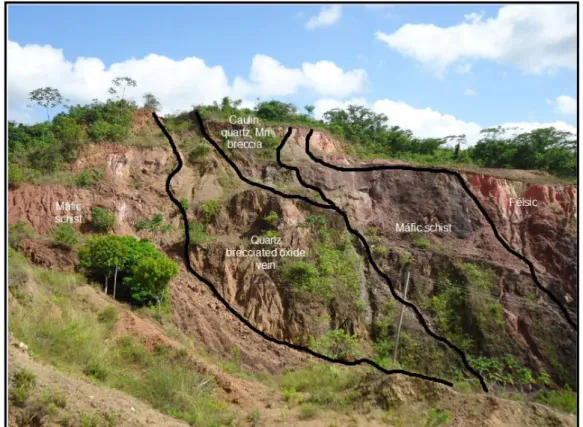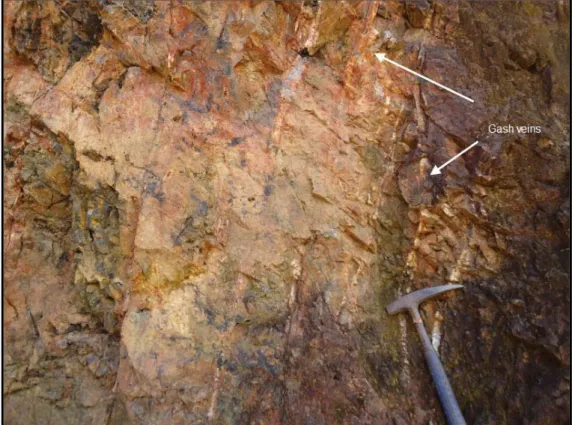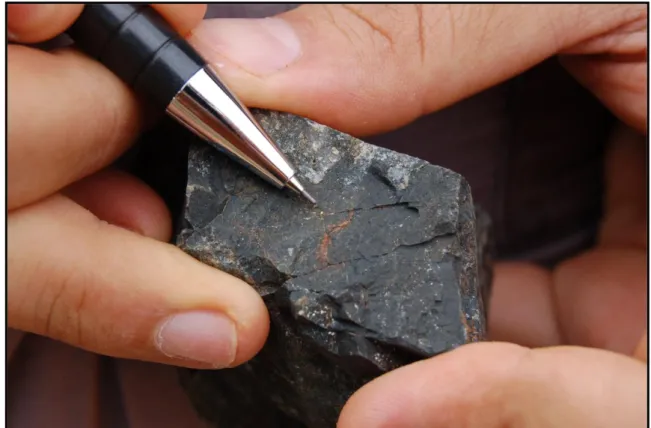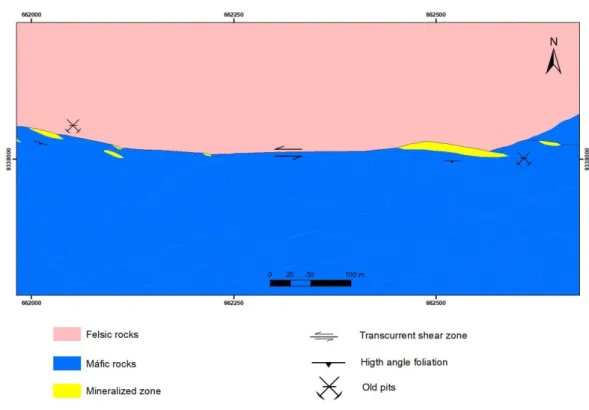Geology and structural control of the Cutia Prospect, Serra Leste, Carajás Mineral
Province, Pará, Brazil
Geologia e controle estrutural do Garimpo Cutia, Serra Leste, Província
Mineral de Carajás, Pará, Brasil
Recebimento dos originais: 18/11/2018 Aceitação para publicação: 20/12/2018
Gilberto Luiz Silva
Graduado em Geologia pela Universidade Federal de Minas Gerais Instituição: BedRock – Consultoria em Geologia.
Endereço: Travessa Artur França, 76 A, Centro, Diamantina, MG e-mail: gilbertoluizsilva@gmail.com
ABSTRACT
The Cutia Prospect is an occurrence of gold located at the Serra Leste, Carajás Mineral Province. This occurrence is related to magnetite/hematite breccia zones, hosted by hydrothermally altered metavolcano-sedimentary rocks in contact wich felsic ignous rock. The contact has a structural control and hosts oxidized quartz veins and mineralized siliceous breccias. This structure has features of a shear zone with characteristics of a brittle-ductile environment, showing a high degree of maturity, represented by breccias and faults, anastomosed foliation and porphyroclast deformation with the formation of kinematic indicators. Structures such as ruptured and rotated layers, tension gashes, well developed foliation and high angle are evidence of a transcurrent shear zone. Exploration activities in the area allowed to verify that the gold was removed from a transition zone of a gossanic sequence where the oxidized zone of the gossan comprises a superficial ferruginous crust.
Keywords: Structural Control, Gold in Shear Zone, Cutia Prospect. RESUMO
O Garimpo da Cutia é uma ocorrência de ouro inserida na Serra Leste, Província Mineral de Carajás. Esta ocorrência esta relacionada a zonas de brechas com magnetita/hematita, hospedadas em rochas metavulcano-sedimentares hidrotermalizadas em contato com rochas ígneas de composição félsica. Este contato é marcado por uma zona de cisalhamento que hospeda veios de quartzo oxidados e brechas silicosas mineralizadas. Essa estrutura tem feições de uma zona de cisalhamento com características de ambiente rúptil-dúctil, mostrando alto grau de maturidade, representada por brechas e falhas, por foliação anastomosada e deformação de porfiroclastos com formação de indicadores cinemáticos. Estruturas como camadas rompidas e rotacionadas, tension gashes, foliação bem desenvolvida e de alto ângulo, são algumas evidências de uma zona de cisalhamento transcorrente. As atividades garimpeiras executadas na área do projeto permitiram verificar que o ouro foi retirado de uma porção correspondente à zona de transição de uma seqüência gossânica, onde a zona oxidada do gossan compreende uma crosta ferruginosa superficial.
Palavras-chave: Controle Estrutural, Ouro na Zona de Cisalhamento, Garimpo Cutia. 1 INTRODUCTION
The Cutia Prospect is located at the Serra Leste, Carajás Mineral Province. This province is characterized by world-class IOCG deposits such as Salobo, Igarapé Bahia, Alemão, Sossego and Cristalino. These deposits are related to magnetite/hematite breccia zones, hosted by hydrothermally altered metavolcano-sedimentary rocks, with a sulfide mineral paragenesis, The Cutia prospect is located at 22 km from the Serra Pelada gold deposit, in Curionópolis-PA, and Au exploration started in 1988. In the years that followed, the site attracted more than 20,000 prospectors in search of the gold metal. About 2,000 kg of gold were extracted from the site until 1992, when the Brazilian government determined the end of the manual mining of prospects throughout the country. In the main pit of the Cutia Prospect, hydrothermally altered rocks of mafic composition outcrop in contact with felsic rocks of granodioritic/tonalitic composition, both highly weathered. The contact between the felsic and mafic rocks is defined by a shear zone that hosts oxidized quartz veins and mineralized siliceous breccias with Au contents of 10.9 and 20.10 g/t over 5 meters intervals which intercepted in the main structure.
Fig. 1: Locatiotn of the Cutia Prospect at Carajás Mineral Province.
2 STRUCTURAL CONTROL
The outcropping rocks in the area present well developed regional foliation mostly with E-W strike and dipping south. Mylonitic foliation is present in some lithologies and is related to local and have regional shear bands. The main structure defines the contact between the mafic/ultramafic
porphyroclast deformation with the formation of kinematic indicators. Structures such as ruptured and rotated layers, tension gashes, well developed foliation and high angle are evidence of a transcurrent shear zone. Brittle-ductile deformation is also registered, referring to a transition environment at the middle crust, where ductile deformation is followed by brittle deformation characterized by brittle reactivations of the structure. The host rocks are metamorphosed to low-grade greenschist to amphibolite facies, which corroborate with this environment. Brittle deformation is evidenced by the cataclasites and breccias that outcrop along the structure that in turn are cut by extensional veins en echelon, in addition to riedel faults and stock works. The ductile deformation is evidenced by mylonitic foliation and asymmetric boudins structures that characterize noncoaxial context, where a relative sinistral movement from east to west, can be observed.
Fig.3 - Mafic host rock with mylonitic foliation.
Fig. 5: gashs veins in the mineralized breccia.
3 MINERALIZATION
The main mineralization is hosted by an oxidized quartz vein with breccias zones. There is an oxidation profile showing iron and manganese oxides in its upper portion. At greater depths, it shows low oxidation, with a microcrystalline matrix of gray staining and magnetic with fragments of microcrystalline quartz. Sulphides are not present, and free gold visible in fracture planes. In relation to the hydrothermal alterations, two generations of veins can be observed, the main vein (1) which is cut by quartz veins of NE orientation and were formed in an extensional environment generating space for crystallization of vugs quartz (2). There is a strong argillic alteration, with abundant kaolin and quartz. Near the contact with the granitoid, this alteration is brecciated and associated with manganese oxides. The association of the hydrothermal alteration zone and the gold mineralization is still unknown. Exploration activities in the project area allowed to verify that the gold was removed from a transition zone of a gossanic sequence, where the oxidized zone of the gossan comprises a superficial ferruginous crust, consisting mainly of iron oxides / hydroxides and breccias with quartz fragments in a matrix composed mainly of goethite and tourmaline.
Fig. 5: mineralized hydrothermal breccia with siliceous matrix.
4 GEOLOGICAL MODEL
The exploration drilling was started in an area where the main prospecting work was carried out, to verify aspects of mineralization and the geological context of the area. The first holes confirmed the presence of the mineralized structure and allowed to confirm and elaborate a preliminary genetic model of mineralization for the study of the most favorable zones / lithologies to host economic mineralization of gold (potentially copper). The main zone was call of CFZ, Cutia Fault Zone. For the development of the research work, a regular grid was developed where a total of 22 exploratory holes were executed along the shear zone between the rocks that make up the main geological units of the area, after that, a geological model for on-site mineralization was developed.
Fig. 8: 3D Geological Model of the CFZ
5 CONCLUSIONS
The gold potential is undeniable, given some old works in the region and the mineralized interceptions where obtained in the drilling program. The genetic model responsible for mineralization and adopted as a prospective model for the area of the Cutia Prospect is the genetic model of “orogenic gold deposits” in medium degree metamorphized shear zones.
REFERENCES
BARROS, C.E.M. DALL’AGNOL, R.; BARBEY, P.; BOULLIER, A.M. 1997. Geochemistry of the Estrela Granite Complex, Carajás region, Brazil: an example of an Archaean A-type granitoid. J. South Amer. Earth Sci., 10(3-4):321-330.
BERNI, G.V.; HEINRICH, C.A.; LOBATO, L.M.; VIC WALL. 2016. Ore mineralogy of the Serra Pelada Au-Pd-Pt deposit, Carajás, Brasil and implications for ore-forming process. Miner Deposita. 51:781-795
DOCEGEO-IGCP. ,1987. Lithostratigraphic review of Carajás District on Southern Pará-Brasil. Rio de Janeiro. IUGS-UNESCO. Final Meeting of the Working Group-Project 204.
GRAINGER, C.J.; GROVES, D.; TALLARICO, F.H.B.; FLETCHER, I.R. 2007. Metallogenesis of the Carajás Mineral Province, southern Amazon Craton, Brazil: varying styles of Archean through Paleoproterozoic to Neoproterozoic base- and precious-metal mineralization. Ore Geology Reviews.
PINHEIRO, R.V.L., HOLDSWORTH, R.E. 1997. Reactivation of Archean strike-slip fault system, Amazon region, Brazil. Journ. Geologia Soc. London, 154:99-103.VILLAS, R.N., SANTOS, M.D. 2001. Gold deposits of the Carajás mineral province: deposit types and metallogenesis. Mineralium Deposit, 36:300-331.





